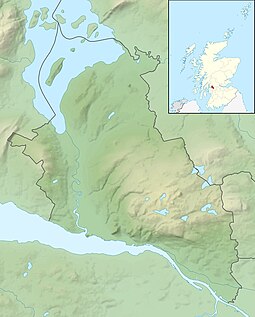Inchconnachan
| Scottish Gaelic name | Innis Chonachain |
|---|---|
| Meaning of name | The Colquhoun's Island |
| Location | |
| OS grid reference | NS375918 |
| Coordinates | 56°05′28″N 4°36′43″W / 56.091°N 4.612°W |
| Physical geography | |
| Island group | Loch Lomond |
| Area | 35 ha[1] |
| Area rank | (Freshwater: 12) [2] |
| Highest elevation | 50 m |
| Administration | |
| Sovereign state | United Kingdom |
| Country | Scotland |
| Council area | Argyll and Bute |
| Demographics | |
| Population | 0 |
| References | [3][4] |

Inchconnachan (Innis Chonachain in Gaelic, meaning 'The Colquhoun's Island') is an island in Loch Lomond in Scotland.
The 1920s wooden bungalow near to the narrows was the holiday home of Lady Arran Colquhoun.
Wildlife
Capercaillie nest here. [5]
Wallabies

Wallabies, of the species Macropus rufogriseus (Red-necked Wallaby), were introduced by Lady Colquhoun in the 1940s, and still roam wild. It is one of the very few places outside Australia which has a viable population of wallabies.[5]
More recently, there has been great controversy over them, and it has been suggested that they should be culled, or eradicated, as they supposedly threaten the capercaillie population.[6] The cull has proven controversial, as some tourists visit the area specifically to see them, and because some animal rights activists consider it cruel.[7] Iain Sheves, factor for Luss Estates, has said,
- "If it comes down a decision between rare native species, which are perhaps better served by being on an island because of predation issues, and a non indigenous population of creatures which shouldn’t really be there then we’ve got to go with the native species every time.
- "I would hope that people come to Scotland to see native wildlife and habitats rather than a quirk of history.
- "Ultimately, we all have a responsibility to try and promote and protect our native wildlife. To disregard that in order to maintain a tourist oddity is not the right thing to do."[8]
Others are skeptical that the wallabies even pose a threat to the capercaillies, as they have lived together for at least 60 years, with no obvious harm done by the wallabies. They also argue that the capercaillies could fly to another island if the wallabies were creating too many problems.[9]
Footnotes
- ^ Rick Livingstone’s Tables of the Islands of Scotland (pdf) Argyll Yacht Charters. Retrieved 12 Dec 2011.
- ^ Area and population ranks: there are c. 300 islands over 20 ha in extent and 93 permanently inhabited islands were listed in the 2011 census.
- ^ Ordnance Survey
- ^ "Overview of Inchconnachan". Gazetteer for Scotland. Retrieved 2007-08-24.
- ^ a b "Loch Lomond Islands: Inchconnachan". Loch Lomond.net. Retrieved 2014-11-05.
- ^ Scottish Daily Record, 06/06/2009 Colony of Wallabies set for cull
- ^ http://www.thesun.co.uk/scotsol/homepage/news/2482725/Wallabies-butchered-on-Loch-Lomonds-Inchconnachan-island.html The Scottish Sun Wallabies butchered
- ^ http://www.lennoxherald.co.uk/dunbartonshire-news/dunbartonshire-news/loch-lomondside-news/2009/06/05/wallabies-face-being-wiped-out-114557-23773081/ Wallabies face being wiped out Jun 5 2009 by Marc McLean, Lennox Herald
- ^ http://www.dailyrecord.co.uk/news/scottish-news/2009/06/06/loch-lomond-wallabies-set-for-cull-to-protect-local-wildlife-86908-21419099/#sitelife-commentsWidget-bottom

